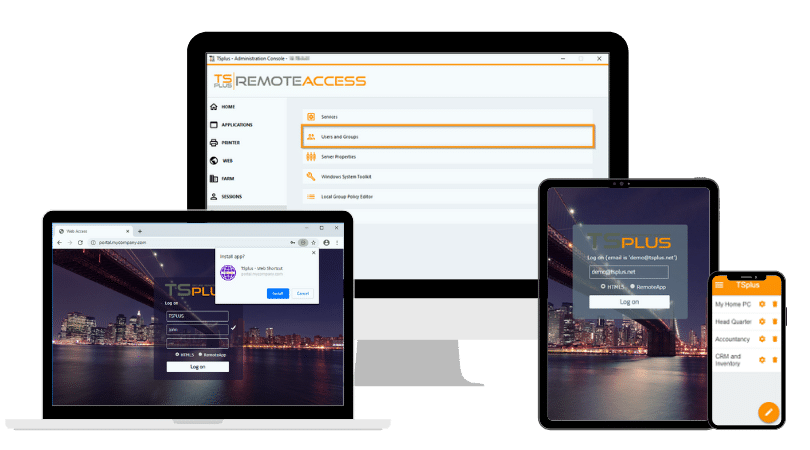TSplus Remote Access Free Trial
Ultimate Citrix/RDS alternative for desktop/app access.Secure, cost-effective,on-permise/cloud
What is a VPN?
A VPN, or Virtual Private Network, encrypts your internet connection, creating a secure tunnel between your device and the office network. This ensures that all data transmitted is protected from unauthorized access, providing a secure way to access sensitive office resources remotely.
By masking your IP address, a VPN also offers anonymity, preventing third parties from tracking your online activities. This secure connection is essential for maintaining the confidentiality and integrity of data, especially when using public or unsecured networks.
How a VPN Works
VPNs work by routing your device’s internet connection through a private server rather than your internet service provider (ISP). This changes your IP address, making it appear as if your connection is coming from the VPN server's location. The VPN server encrypts all data transmitted between your device and the office network.
This encryption process converts readable data into a coded format, ensuring that even if the data is intercepted, it cannot be read without the decryption key. This method secures sensitive information such as login credentials, emails, and financial transactions, maintaining privacy and security.
VPN Protocols
- PPTP (Point-to-Point Tunneling Protocol): One of the oldest protocols, offering basic encryption but faster speeds. Suitable for simple applications but less secure compared to modern protocols.
- L2TP/IPsec (Layer 2 Tunneling Protocol): Provides stronger security by combining L2TP with IPsec for encryption. It encapsulates data twice, adding a layer of protection but potentially slowing down the connection.
- OpenVPN: Highly secure and open-source, known for its flexibility and strong encryption standards. It uses SSL/TLS for key exchange and can traverse firewalls and network address translators (NATs).
- IKEv2/IPsec (Internet Key Exchange version 2): Offers high security and is particularly effective for mobile devices due to its ability to maintain connections when switching networks. It supports strong encryption algorithms and offers robust stability and speed.
Each protocol has its strengths and weaknesses, and the choice depends on the specific needs and resources of the organization. For instance, OpenVPN is highly configurable and secure, making it suitable for environments where strong encryption is necessary. In contrast, PPTP, though less secure, might be chosen for its speed and ease of setup in less critical scenarios.
Benefits of Using a VPN
Enhanced Security
VPNs encrypt your data, making it inaccessible to hackers and cybercriminals. This is especially important when accessing the internet over public Wi-Fi networks, which are often insecure.
Remote Access
A VPN allows employees to access the office network from anywhere in the world. This means that employees can work from home, on the go, or from remote locations while maintaining secure access to necessary resources.
Cost-Effective
Implementing a VPN can reduce the need for expensive physical infrastructure and dedicated leased lines. VPNs use the existing internet infrastructure, making them a cost-effective solution for secure remote access.
Privacy
By masking your IP address, a VPN helps maintain privacy. This is particularly useful for bypassing regional restrictions and censorship, ensuring that your online activities remain private.
Types of VPNs
Remote Access VPN
Remote Access VPNs are used by individual users to connect to a private network remotely. This type of VPN is ideal for employees working from home or on the move.
Setup and Configuration
- VPN Server: Your office needs a VPN server configured with the necessary security settings.
- VPN Client Software: Install compatible VPN client software on your device.
- Credentials: Obtain the VPN server address, VPN type, and login credentials from your IT department.
Site-to-Site VPN
Site-to-Site VPNs connect entire networks to each other, typically used to link branch offices to a central office. This setup is useful for organizations with multiple locations that need to share resources securely.
Setup and Configuration
- Network Infrastructure: Ensure both sites have compatible network infrastructure and VPN-capable routers.
- VPN Gateway: Configure VPN gateways at both sites to establish the connection.
- Routing Configuration: Set up routing to ensure traffic between sites is properly directed through the VPN tunnel.
VPN as a Service (VPNaaS)
Cloud-based VPN solutions offer flexibility and scalability, making them suitable for businesses looking to avoid the hassle of maintaining physical VPN servers. VPNaaS is ideal for businesses that leverage cloud resources extensively.
Setup and Configuration
- Select a Provider: Choose a reputable VPNaaS provider.
- Provisioning: Configure your VPN settings through the provider’s dashboard.
- Integration: Integrate VPNaaS with your existing cloud services and infrastructure.
Setting Up a VPN to Connect to Your Office Network
Prerequisites
- VPN Server: Ensure your office has a VPN server set up and configured.
- VPN Client Software: Install the appropriate VPN client software on your device.
- Credentials: Obtain the necessary VPN details such as server address, type, and login credentials from your IT department.
Step-by-Step Guide
For Windows Users
- Open Settings: Navigate to
Settings > Network & Internet > VPN. - Add a VPN Connection: Click
Add a VPN connection. - Enter VPN Details: Fill in the VPN provider, connection name, server name, VPN type, and login information.
- Save and Connect: Click
Save, then select the VPN connection and click Connect.
For Mac Users
- Open System Preferences: Go to
System Preferences > Network. - Add VPN Configuration: Click the
+ button to add a new VPN configuration. - Enter VPN Details: Select the VPN type and enter the server address, account name, and authentication settings.
- Apply and Connect: Click
Apply, then Connect.
Troubleshooting Common Issues
- Connection Failures: Ensure your internet connection is stable, and that the VPN server is online.
- Authentication Errors: Double-check your login credentials and VPN configuration details.
- Network Restrictions: Some networks may block VPN connections; try using a different network or consult your IT team.
Best Practices for VPN Security
Use Strong Passwords
Ensure that all VPN accounts use strong, unique passwords to prevent unauthorized access. A strong password typically includes a mix of uppercase and lowercase letters, numbers, and special characters. Passwords should be at least 12 characters long and avoid common words or easily guessable information.
Encourage the use of password managers to create and store complex passwords securely. Password managers can generate highly secure passwords and store them in an encrypted format, reducing the risk of password reuse and simplifying password management for users.
Regularly Update Software
Keep your VPN client and server software up to date to protect against known vulnerabilities. Regular updates ensure that you have the latest security patches and features, which can prevent exploitation of known weaknesses.
Enable automatic updates if available or set a regular schedule for manual updates. Regularly review update logs and security bulletins from your VPN provider to stay informed about critical patches and enhancements.
Enable Multi-Factor Authentication (MFA)
Adding an extra layer of security, MFA requires users to provide two or more verification factors to gain access. This significantly reduces the risk of unauthorized access by ensuring that even if a password is compromised, additional verification is needed. Common MFA methods include one-time passwords (OTPs) sent via SMS or email, authenticator apps, and biometric verification like fingerprint or facial recognition. Implementing MFA adds a robust security layer, especially for accounts with access to sensitive information.
Monitor VPN Usage
Regularly monitor and log VPN activity to detect any unusual access patterns. This helps in identifying and responding to potential security threats promptly. Implement logging to capture detailed connection data, including user logins, IP addresses, connection times, and accessed resources.
Use security information and event management (SIEM) systems to analyze logs for anomalies and generate alerts for suspicious activities. Regular reviews and audits of VPN logs are essential for proactive security management and incident response.
Why Choose TSplus
For a seamless and secure remote working experience, consider TSplus Remote Access. TSplus provides an easy-to-use, robust remote desktop and application delivery solution that integrates VPN functionalities to ensure your remote connections are always secure and reliable. Explore TSplus solutions today to enhance your business's remote work capabilities.
Connecting to your office network from home using a VPN is a vital skill for IT professionals. By understanding the types of VPNs, setting them up correctly, and following best practices, you can maintain secure and productive remote work environments.
Conclusion
Setting up a VPN for your office network is crucial for enhancing security and enabling remote work. By following the detailed steps and best practices outlined in this guide, IT professionals can ensure a secure and efficient remote working environment.
TSplus Remote Access Free Trial
Ultimate Citrix/RDS alternative for desktop/app access.Secure, cost-effective,on-permise/cloud









)



)
)
)
)



